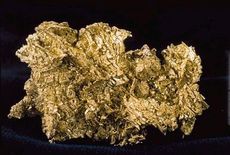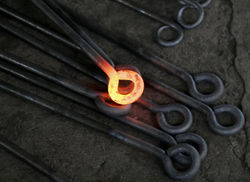Metal
2007 Schools Wikipedia Selection. Related subjects: General Chemistry
In chemistry, a metal ( Greek: Metallon) is an element that readily forms positive ions (cations) and has metallic bonds. Metals are sometimes described as a lattice of positive ions surrounded by a cloud of delocalized electrons. The metals are one of the three groups of elements as distinguished by their ionisation and bonding properties, along with the metalloids and nonmetals. On the periodic table, a diagonal line drawn from boron (B) to polonium (Po) separates the metals from the nonmetals. Elements on this line are metalloids, sometimes called semi-metals; elements to the lower left are metals; elements to the upper right are nonmetals.
A modern definition of metals is that they have overlapping conduction bands and valence bands in their electronic structure. This definition opens up the category for metallic polymers and other organic metals, which have been made by researchers and employed in high-tech devices. These synthetic materials often have the characteristic silvery-grey reflectiveness of elemental metals.
The traditional definition focuses on the bulk properties of metals. They tend to be lustrous, ductile, malleable, and good conductors of electricity, while nonmetals are generally brittle (for solid nonmetals), lack lustre, and are insulators.
Occurrence
Nonmetal elements are more commonplace on Earth than metallic elements are, but metals in fact constitute most of the periodic table. Some popular metals are aluminium, copper, gold, iron, lead, silver, titanium, uranium and zinc.
Chemical properties
Most metals are chemically unstable, reacting with oxygen in the air to form oxides over varying timescales (for example iron rusts over years and potassium burns in seconds). The alkali metals react quickest followed by the alkaline earth metals, found in the leftmost two groups of the periodic table. The transition metals take much longer to oxidise (such as iron, copper, zinc, nickel). Others, like palladium, platinum and gold, do not react with the atmosphere at all. Some metals form a barrier layer of oxide on their surface which cannot be penetrated by further oxygen molecules and thus retain their shiny appearance and good conductivity for many decades (like aluminium, some steels, and titanium). The oxides of metals are basic (as opposed to those of nonmetals, which are acidic), although this may be considered a rule of thumb, rather than an absolute condition.
Painting or anodising metals are good ways to prevent their corrosion. However, a more reactive metal in the electrochemical series must be chosen for coating, especially when chipping of the coating is expected. Water and the two metals form an electrochemical cell, and if the coating is less reactive than the coatee, the coating actually promotes corrosion.
Physical properties
Traditionally, metals have certain characteristic physical properties: they are usually shiny (they have "lustre"), have a high density, are ductile and malleable, usually have a high melting point, are usually hard, and conduct electricity and heat well. However this is mainly because the low density, soft, low melting point metals happen to be reactive, and we rarely encounter them in their elemental, metallic form. Metals conduct sound well, that is, they are sonorous.
The electrical and thermal conductivity of metals originate from the fact, that in the metallic bond the outer electrons of the metal atoms form a gas of nearly free electrons, moving as an electron gas in a background of positive charge formed by the ion cores. Good mathematical predictions for electrical conductivity, as well as the electrons' contribution to the heat capacity and heat conductivity of metals can be calculated from the free electron model, which does not take the detailed structure of the ion lattice into account.
When considering the exact band structure and binding energy of a metal, it is necessary to take into account the positive potential caused by the specific arangement of the ion cores - which is periodic in crystals. The most important consequence of the periodic potential is the formation of a small band gap at the boundary of the brillouin zone. Mathematically, the potential of the ion cores is treated in the nearly-free electron model.
Alloys
An alloy is a mixture of two or more elements in solid solution in which the major component is a metal. Most pure metals are either too soft, brittle or chemically reactive for practical use. Combining different ratios of metals as alloys modify the properties of pure metals to produce desirable characteristics. The aim of making alloys is to make them less brittle, harder, resistant to corrosion, or have a more desirable colour and luster. Examples of alloys are steel (iron and carbon), brass (copper and zinc), bronze (copper and tin), and duralumin (aluminium and copper). Alloys specially designed for highly demanding applications, such as jet engines, may contain more than ten elements.
Base metal
In chemistry, the term base metal is used informally to refer to a metal that oxidizes or corrodes relatively easily, and reacts variably with dilute hydrochloric acid (HCl) to form hydrogen. Examples include iron, nickel, lead and zinc. Copper is considered a base metal as it oxidizes relatively easily, although it does not react with HCl. It is commonly used in opposition to noble metal.
In alchemy, a base metal was a common and inexpensive metal, as opposed to precious metals, mainly gold and silver. A longtime goal of the alchemists was the transmutation of base metals into precious metals.
In numismatics, coins used to derive their value primarily from the precious metal content. Most modern currencies are fiat currency, allowing the coins to be made of base metal.
Precious metal

A precious metal is a rare metallic chemical element of high economic value.
Chemically, the precious metals are less reactive than most elements, have high lustre and high electrical conductivity. Historically, precious metals were important as currency, but are now regarded mainly as investment and industrial commodities. Gold, silver, platinum and palladium each have an ISO 4217 currency code.
The best-known precious metals are gold and silver. While both have industrial uses, they are better known for their uses in art, jewelry, and coinage. Other precious metals include the Platinum group metals: ruthenium, rhodium, palladium, osmium, iridium, and platinum, of which platinum is the most widely traded. Plutonium and uranium could also be considered precious metals.
The demand for precious metals is driven not only by their practical use, but also by their role as investments and a store of value. Palladium was, as of summer 2006, valued at a little under half the price of gold, and platinum at around twice that of gold. Silver is substantially less expensive than these metals, but is often traditionally considered a precious metal for its role in coinage and jewelry.
Astronomy
In the specialised usage of astronomy and astrophysics, the term "metal" is often used to refer to any element other than hydrogen or helium, and includes substances as chemically non-metallic as neon, fluorine, and oxygen. Because the temperatures of stellar bodies allow practically no solid or liquid matter, and little normal chemistry can exist at temperatures that break down almost all chemical bonds, the term "metal" refers to materials that result from the triple-helium process which are much scarcer than hydrogen and helium in stars in the main sequence.
See metallicity.
